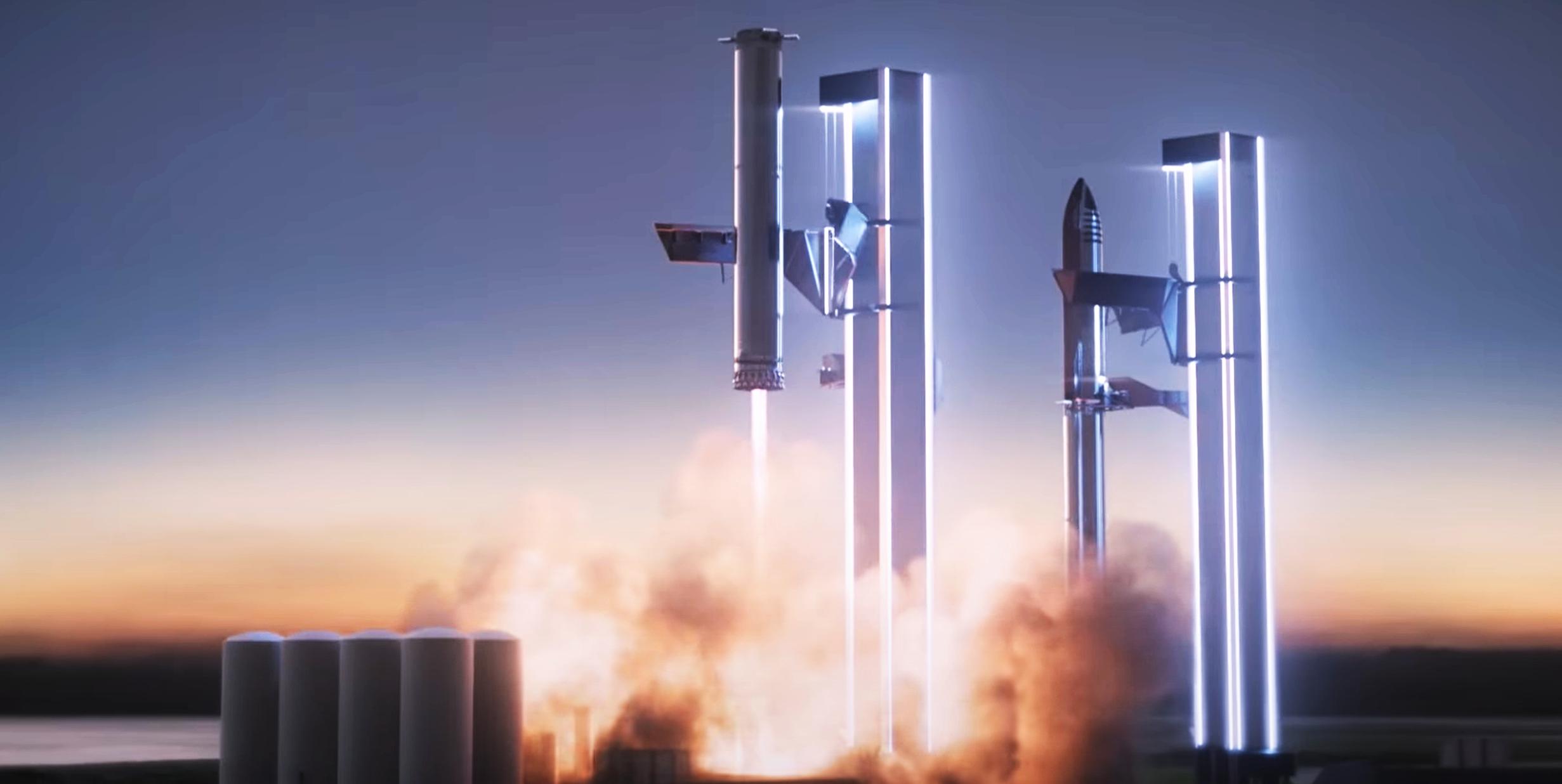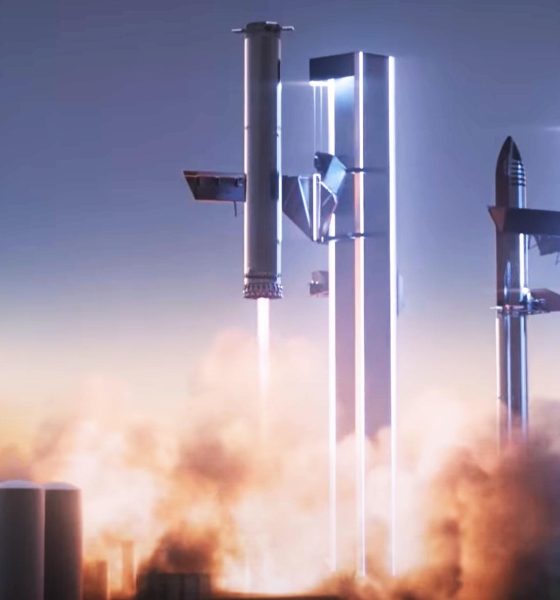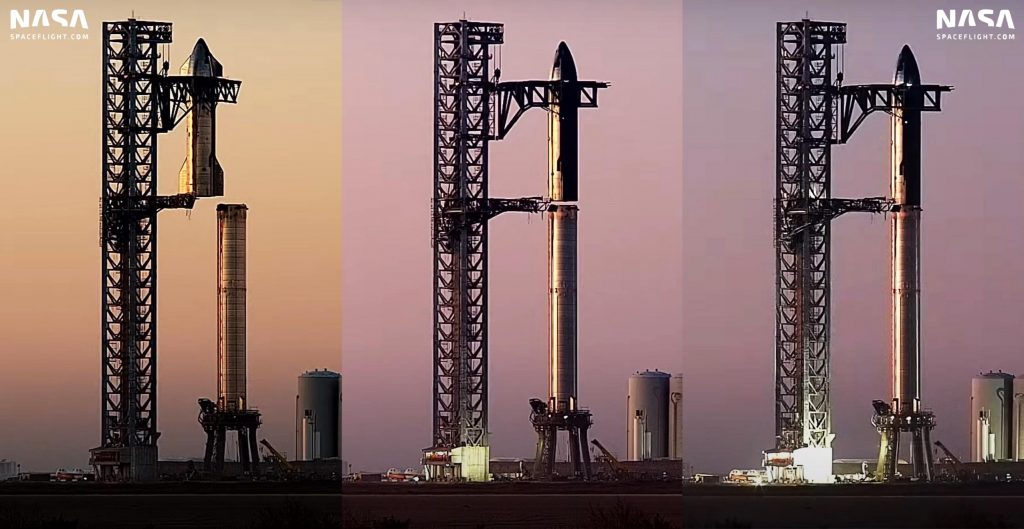

News
SpaceX wants to attempt Starship booster catch during first orbital launch
An updated document submitted by SpaceX to the US Federal Communications Commission (FCC) has revealed details about the company’s plan for the first Starship booster ‘catch’ attempt.
The document follows a different batch submitted by SpaceX in June 2021, when the company detailed its plans for Starship’s orbital launch debut as background while requesting permission from the FCC to use Starlink dishes for in-flight telemetry. A month earlier, a different request focused on more standard telemetry antennas had already revealed that even if the mission went perfectly, Starship would not fully reach orbit on its first attempted spaceflight. It also confirmed that SpaceX had no intention of recovering the upper stage or Super Heavy booster assigned to Starship’s launch debut – a sort of implicit acknowledgment that success was (then) not expected on the first try.
Twelve months later, SpaceX has submitted an updated overview of Starship’s orbital launch debut in a new request for permission to use multiple Starlink dishes on both stages. While most of the document is the same, a few particular details have changed about Super Heavy’s role in the mission.
This time around, SpaceX says that the Super Heavy booster will “will separate[,] perform a partial return[,] and land in the Gulf of Mexico or return to Starbase and be caught by the launch tower.” Prior to this document, SpaceX’s best-case plans for the first Super Heavy booster to launch never strayed from a controlled splashdown in the Gulf of Mexico – potentially demonstrating that it would be safe to attempt booster recovery on the next launch but all but guaranteeing that the first booster would be lost at sea.
A year later, SpaceX appears to be a bit more confident and wants to leave itself the option to attempt to recover the first Super Heavy booster that launches. However, the company has dramatically complicated the process of testing early Super Heavy and Starship recovery (and thus reuse) by fully removing traditional and predictable landing legs and designing its latest prototypes such that the only way they can be recovered in one piece is with a giant mechanized ‘launch tower’ nicknamed Mechazilla.

The launch tower and its three mobile arms will play a crucial role in all aspects of orbital Starship launches. The first arm swings out to brace Super Heavy for Starship installation and connect the upper stage to power, propellant supplies, and other launch pad utilities. A more exotic pair of arms nicknamed ‘chopsticks’ has a more complex job. On top of using the chopsticks to lift, stack, and demate Starships and Super Heavy boosters and almost any weather and wind conditions, SpaceX wants to use the arms as an incredibly complex and precarious rocket recovery system.
For a booster or Starship “catch,” the rocket will approach the tower, enter the gap between the splayed arms, hover in place while the arms close around it, and eventually come to rest on hardpoints that appear to offer about as much surface area as a coffee table. Based on a simulation of the process shown by Elon Musk, calling it a “catch” is a misnomer, as the arms will mainly move in one dimension (open/close) and can’t actually ‘grab’ the rocket in any real sense. As built and shown, they are closer to a tiny fixed landing platform capable of minor last-second positional adjustments.
Eventually, the chopsticks could shave a small amount of time off of post-recovery processing, removing the need for a crane (or the same arms) to attach to a landed booster or ship. They could also shave off the dry mass required for landing legs, though all interplanetary ships will still need legs. However, they will also inherently make proving their own efficacy a nightmare. By all appearances, the current recovery mechanisms on the arms and the landing hardpoints on ships and boosters mean that a ‘catch’ could fail if either stage is more than a foot or two from a perfect bullseye or rotated a few degrees in the wrong direction. With the method SpaceX has devised, even the tiniest error could easily end with a massive, pressurized, partially-fueled rocket destroying the chopsticks and plummeting a few hundred feet to the ground, guaranteeing an explosion that could damage surrounding infrastructure or start fires that might.
In the event of larger anomalies during a landing attempt, Starship or Super Heavy could accidentally impact the launch tower, damaging or even outright destroying the skyscraper-sized structure. Ultimately, the immense risk posed by any catch attempt means that unless SpaceX has miraculously gotten the design of everything involved nearly perfect on its first try, the company will have to be extraordinarily cautious and expend a large number of ships and boosters to avoid rendering its only Starship launch tower unusable.
At least to some extent, SpaceX likely knows this and Super Heavy would likely need to be in excellent health and perform perfectly during the ascent and boostback portions of its launch debut to be cleared for a catch attempt. Ultimately, Starship’s first orbital launch could end up being even more of a spectacle than it’s already guaranteed to be.

Elon Musk
Starlink passes 9 million active customers just weeks after hitting 8 million
The milestone highlights the accelerating growth of Starlink, which has now been adding over 20,000 new users per day.

SpaceX’s Starlink satellite internet service has continued its rapid global expansion, surpassing 9 million active customers just weeks after crossing the 8 million mark.
The milestone highlights the accelerating growth of Starlink, which has now been adding over 20,000 new users per day.
9 million customers
In a post on X, SpaceX stated that Starlink now serves over 9 million active users across 155 countries, territories, and markets. The company reached 8 million customers in early November, meaning it added roughly 1 million subscribers in under seven weeks, or about 21,275 new users on average per day.
“Starlink is connecting more than 9M active customers with high-speed internet across 155 countries, territories, and many other markets,” Starlink wrote in a post on its official X account. SpaceX President Gwynne Shotwell also celebrated the milestone on X. “A huge thank you to all of our customers and congrats to the Starlink team for such an incredible product,” she wrote.
That growth rate reflects both rising demand for broadband in underserved regions and Starlink’s expanding satellite constellation, which now includes more than 9,000 low-Earth-orbit satellites designed to deliver high-speed, low-latency internet worldwide.
Starlink’s momentum
Starlink’s momentum has been building up. SpaceX reported 4.6 million Starlink customers in December 2024, followed by 7 million by August 2025, and 8 million customers in November. Independent data also suggests Starlink usage is rising sharply, with Cloudflare reporting that global web traffic from Starlink users more than doubled in 2025, as noted in an Insider report.
Starlink’s momentum is increasingly tied to SpaceX’s broader financial outlook. Elon Musk has said the satellite network is “by far” the company’s largest revenue driver, and reports suggest SpaceX may be positioning itself for an initial public offering as soon as next year, with valuations estimated as high as $1.5 trillion. Musk has also suggested in the past that Starlink could have its own IPO in the future.
News
NVIDIA Director of Robotics: Tesla FSD v14 is the first AI to pass the “Physical Turing Test”
After testing FSD v14, Fan stated that his experience with FSD felt magical at first, but it soon started to feel like a routine.

NVIDIA Director of Robotics Jim Fan has praised Tesla’s Full Self-Driving (Supervised) v14 as the first AI to pass what he described as a “Physical Turing Test.”
After testing FSD v14, Fan stated that his experience with FSD felt magical at first, but it soon started to feel like a routine. And just like smartphones today, removing it now would “actively hurt.”
Jim Fan’s hands-on FSD v14 impressions
Fan, a leading researcher in embodied AI who is currently solving Physical AI at NVIDIA and spearheading the company’s Project GR00T initiative, noted that he actually was late to the Tesla game. He was, however, one of the first to try out FSD v14.
“I was very late to own a Tesla but among the earliest to try out FSD v14. It’s perhaps the first time I experience an AI that passes the Physical Turing Test: after a long day at work, you press a button, lay back, and couldn’t tell if a neural net or a human drove you home,” Fan wrote in a post on X.
Fan added: “Despite knowing exactly how robot learning works, I still find it magical watching the steering wheel turn by itself. First it feels surreal, next it becomes routine. Then, like the smartphone, taking it away actively hurts. This is how humanity gets rewired and glued to god-like technologies.”
The Physical Turing Test
The original Turing Test was conceived by Alan Turing in 1950, and it was aimed at determining if a machine could exhibit behavior that is equivalent to or indistinguishable from a human. By focusing on text-based conversations, the original Turing Test set a high bar for natural language processing and machine learning.
This test has been passed by today’s large language models. However, the capability to converse in a humanlike manner is a completely different challenge from performing real-world problem-solving or physical interactions. Thus, Fan introduced the Physical Turing Test, which challenges AI systems to demonstrate intelligence through physical actions.
Based on Fan’s comments, Tesla has demonstrated these intelligent physical actions with FSD v14. Elon Musk agreed with the NVIDIA executive, stating in a post on X that with FSD v14, “you can sense the sentience maturing.” Musk also praised Tesla AI, calling it the best “real-world AI” today.
News
Tesla AI team burns the Christmas midnight oil by releasing FSD v14.2.2.1
The update was released just a day after FSD v14.2.2 started rolling out to customers.

Tesla is burning the midnight oil this Christmas, with the Tesla AI team quietly rolling out Full Self-Driving (Supervised) v14.2.2.1 just a day after FSD v14.2.2 started rolling out to customers.
Tesla owner shares insights on FSD v14.2.2.1
Longtime Tesla owner and FSD tester @BLKMDL3 shared some insights following several drives with FSD v14.2.2.1 in rainy Los Angeles conditions with standing water and faded lane lines. He reported zero steering hesitation or stutter, confident lane changes, and maneuvers executed with precision that evoked the performance of Tesla’s driverless Robotaxis in Austin.
Parking performance impressed, with most spots nailed perfectly, including tight, sharp turns, in single attempts without shaky steering. One minor offset happened only due to another vehicle that was parked over the line, which FSD accommodated by a few extra inches. In rain that typically erases road markings, FSD visualized lanes and turn lines better than humans, positioning itself flawlessly when entering new streets as well.
“Took it up a dark, wet, and twisty canyon road up and down the hill tonight and it went very well as to be expected. Stayed centered in the lane, kept speed well and gives a confidence inspiring steering feel where it handles these curvy roads better than the majority of human drivers,” the Tesla owner wrote in a post on X.
Tesla’s FSD v14.2.2 update
Just a day before FSD v14.2.2.1’s release, Tesla rolled out FSD v14.2.2, which was focused on smoother real-world performance, better obstacle awareness, and precise end-of-trip routing. According to the update’s release notes, FSD v14.2.2 upgrades the vision encoder neural network with higher resolution features, enhancing detection of emergency vehicles, road obstacles, and human gestures.
New Arrival Options also allowed users to select preferred drop-off styles, such as Parking Lot, Street, Driveway, Parking Garage, or Curbside, with the navigation pin automatically adjusting to the ideal spot. Other refinements include pulling over for emergency vehicles, real-time vision-based detours for blocked roads, improved gate and debris handling, and Speed Profiles for customized driving styles.








